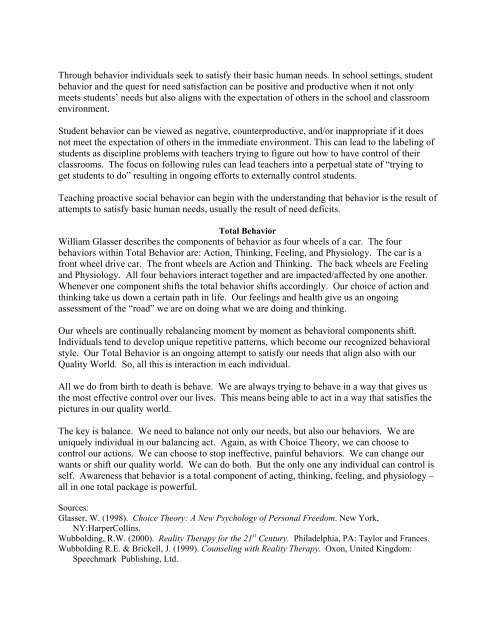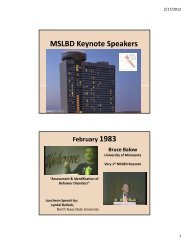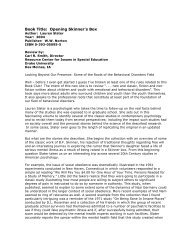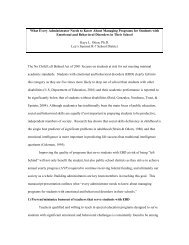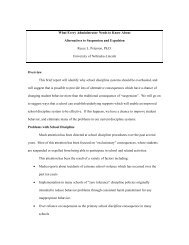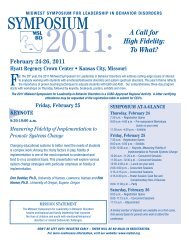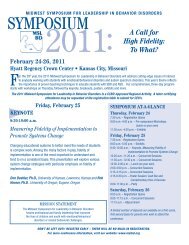Handout Frey in Adobe PDF document, 30Kb - MSLBD
Handout Frey in Adobe PDF document, 30Kb - MSLBD
Handout Frey in Adobe PDF document, 30Kb - MSLBD
Create successful ePaper yourself
Turn your PDF publications into a flip-book with our unique Google optimized e-Paper software.
Through behavior <strong>in</strong>dividuals seek to satisfy their basic human needs. In school sett<strong>in</strong>gs, student<br />
behavior and the quest for need satisfaction can be positive and productive when it not only<br />
meets students’ needs but also aligns with the expectation of others <strong>in</strong> the school and classroom<br />
environment.<br />
Student behavior can be viewed as negative, counterproductive, and/or <strong>in</strong>appropriate if it does<br />
not meet the expectation of others <strong>in</strong> the immediate environment. This can lead to the label<strong>in</strong>g of<br />
students as discipl<strong>in</strong>e problems with teachers try<strong>in</strong>g to figure out how to have control of their<br />
classrooms. The focus on follow<strong>in</strong>g rules can lead teachers <strong>in</strong>to a perpetual state of “try<strong>in</strong>g to<br />
get students to do” result<strong>in</strong>g <strong>in</strong> ongo<strong>in</strong>g efforts to externally control students.<br />
Teach<strong>in</strong>g proactive social behavior can beg<strong>in</strong> with the understand<strong>in</strong>g that behavior is the result of<br />
attempts to satisfy basic human needs, usually the result of need deficits.<br />
Total Behavior<br />
William Glasser describes the components of behavior as four wheels of a car. The four<br />
behaviors with<strong>in</strong> Total Behavior are: Action, Th<strong>in</strong>k<strong>in</strong>g, Feel<strong>in</strong>g, and Physiology. The car is a<br />
front wheel drive car. The front wheels are Action and Th<strong>in</strong>k<strong>in</strong>g. The back wheels are Feel<strong>in</strong>g<br />
and Physiology. All four behaviors <strong>in</strong>teract together and are impacted/affected by one another.<br />
Whenever one component shifts the total behavior shifts accord<strong>in</strong>gly. Our choice of action and<br />
th<strong>in</strong>k<strong>in</strong>g take us down a certa<strong>in</strong> path <strong>in</strong> life. Our feel<strong>in</strong>gs and health give us an ongo<strong>in</strong>g<br />
assessment of the “road” we are on do<strong>in</strong>g what we are do<strong>in</strong>g and th<strong>in</strong>k<strong>in</strong>g.<br />
Our wheels are cont<strong>in</strong>ually rebalanc<strong>in</strong>g moment by moment as behavioral components shift.<br />
Individuals tend to develop unique repetitive patterns, which become our recognized behavioral<br />
style. Our Total Behavior is an ongo<strong>in</strong>g attempt to satisfy our needs that align also with our<br />
Quality World. So, all this is <strong>in</strong>teraction <strong>in</strong> each <strong>in</strong>dividual.<br />
All we do from birth to death is behave. We are always try<strong>in</strong>g to behave <strong>in</strong> a way that gives us<br />
the most effective control over our lives. This means be<strong>in</strong>g able to act <strong>in</strong> a way that satisfies the<br />
pictures <strong>in</strong> our quality world.<br />
The key is balance. We need to balance not only our needs, but also our behaviors. We are<br />
uniquely <strong>in</strong>dividual <strong>in</strong> our balanc<strong>in</strong>g act. Aga<strong>in</strong>, as with Choice Theory, we can choose to<br />
control our actions. We can choose to stop <strong>in</strong>effective, pa<strong>in</strong>ful behaviors. We can change our<br />
wants or shift our quality world. We can do both. But the only one any <strong>in</strong>dividual can control is<br />
self. Awareness that behavior is a total component of act<strong>in</strong>g, th<strong>in</strong>k<strong>in</strong>g, feel<strong>in</strong>g, and physiology –<br />
all <strong>in</strong> one total package is powerful.<br />
Sources:<br />
Glasser, W. (1998). Choice Theory: A New Psychology of Personal Freedom. New York,<br />
NY:HarperColl<strong>in</strong>s.<br />
Wubbold<strong>in</strong>g, R.W. (2000). Reality Therapy for the 21 st Century. Philadelphia, PA: Taylor and Frances.<br />
Wubbold<strong>in</strong>g R.E. & Brickell, J. (1999). Counsel<strong>in</strong>g with Reality Therapy. Oxon, United K<strong>in</strong>gdom:<br />
Speechmark Publish<strong>in</strong>g, Ltd.


